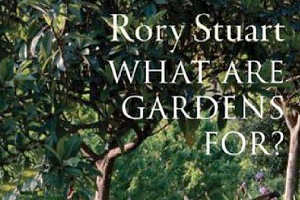What are gardens for?
 Sandy Felton finds some answers to the question we often ask ourselves, ‘What Are Gardens For?” in Rory Stuart’s new book.
Sandy Felton finds some answers to the question we often ask ourselves, ‘What Are Gardens For?” in Rory Stuart’s new book.
I suspect that if you gathered a group of people into a room and asked them what they think gardens are for, you would get as many answers as there are stars in the heavens. So it is a brave man who asks the question and then goes on expertly to answer it in a lively, thought provoking and analytical way.
In ‘What Are Gardens For?’ Rory Stuart explores the many different reasons why people enjoy making and visiting gardens. It is a subject which has quite intimidated me over the years for although I have spent decades making and visiting gardens I have never felt totally relaxed about explaining why I liked or disliked a particular one. The fiercest arguments in the gardening world are often the result of a review or blog of a garden that has been visited and I have seen total war break out in some quarters as to the merits or otherwise of a particular garden.
I well remember recently saying that I thought a very well known garden I had visited was quirky, entertaining and enjoyable and getting into a great discussion with another garden aficionado who said she thought it was indulgent and tacky. Were we seeing the same garden as to be so polarised in our opinion.
I was hopeful that by reading Rory’s book I could find some enlightenment as to my particular view on what a garden is for and I am pleased to say I succeeded, or rather he did, in making me view for the first time the various themes I needed to explore before I could fully appreciate what I was looking at rather than passively accepting what I saw.
A garden might offer an opportunity for creative expression, simply be a rewarding motive for taking physical exercise, act as a retreat from the pressure of everyday life or aid in psychological or spiritual recovery. The healing aspect of gardening or garden visiting cannot be overlooked nor the rewarding satisfaction of growing your own food.
The author encourages us to cast a more analytical eye over our own gardens and the gardens we visit. Through his discussions of the Old Vicarage, East Ruston in Norfolk, the Alnwick Garden and Veddw House Garden in Monmouthshire, he shows how we can gain much more from a garden if we actively study it rather than passively accepting what we see.
By gathering together a wide range of quotations and observations, the author presents us with an entertaining and thoughtful exploration of the different ways gardens can be perceived and enjoyed. He cites Robin Lane Fox, one of the best writers on gardens, who commented that we are drawn to realise that the eye delights in colour and so it misses much if it sees nothing more. To view a garden as a collection of plants or series of pictures is failing to appreciate the sculptural qualities of the plantings and the architectural qualities of the garden’s design.
This hits the spot and I suddenly find myself starting to understand, or at least I think I am.
The book takes a circular passage to this complex subject so the author often approaches the same point from a different direction. I found this helpful. Following the initial chapter which asks the question, what are gardens for? the author then goes on to cover areas such as garden visiting, the garden critic, style and meaning, taste and memory and atmosphere. I was particularly drawn to the chapter on memory and atmosphere, because for me this is often what I sense first and lingers last.
Rory Stuart inherited a Cotswold cottage with a beautiful garden which stimulated him to look at plants and gardens more critically. Eventually he took a course in garden design and set up as a designer. He has led garden tours in France, India and Italy and his fascination with gardens has now taken him to Rome where he is learning how to grow plants in the challenging conditions of the hills outside the city.
I found the book an excellent and enjoyable read and yes thought provoking. It covers ground rarely examined by others and assimilates the thoughts of a wide range of writers. With Christmas lists probably coming into mind, it would make an excellent present for a gardening friend. Personally, I don’t think I will ever look at a garden in quite the same way again and for that I thank Rory Stuart, for he has taken me by the hand and stimulated an awareness of so many aspects of a garden that previously I just hadn’t even considered. Quite an achievement!
‘What Are Gardens For?’ – Visiting, Experiencing and Thinking about Gardens – by Rory Stuart, published by Frances Lincoln is in hardback at £16.99.

